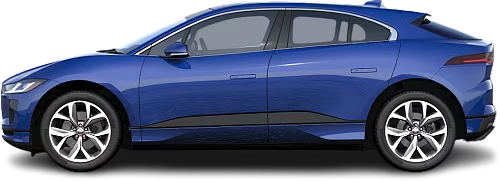Global EV Comparison: Tesla Model S 75 vs Jaguar I-Pace EV320
Struggling to Decide? Let AI Help!
Your AI Summary Is Ready!
General Info
Since both vehicles have been discontinued, they are now only available on the used car market. You can get the Tesla Model S 75 (2016-2017) for as low as €19990, while the Jaguar I-Pace EV320 (2020-2024) begins at €29470.
The Tesla Model S 75 (2016-2017) is a Liftback, whereas the Jaguar I-Pace EV320 (2020-2024) is a SUV.
| Property | Tesla Model S 75 | Jaguar I-Pace EV320 |
|---|---|---|
| Years of Production | 2016-2017 | 2020-2024 |
| Current Status | Discontinued | Discontinued |
| Country of Manufacture | Netherlands, USA | Austria |
| Body Style | Liftback | SUV |
| Market Availability | EU, USA | EU |
| Price Europe (Used) | €19990 | €29470 |
| GCC Score | 6.4 | 6.1 |
Range and Efficiency
While the Jaguar I-Pace EV320 (2020-2024) offers a longer real-world range and a bigger battery, it is less energy-efficient than the Tesla Model S 75 (2016-2017).
| Property | Tesla Model S 75 | Jaguar I-Pace EV320 |
|---|---|---|
| Range (EPA) | 401 km | - Range (EPA) |
| Range (WLTP) | - Range (WLTP) | 470 km |
| Range (GCC) | 370 km | 383 km |
| Battery Capacity (Nominal) | 75 kWh | 90 kWh |
| Battery Capacity (Usable) | 72.5 kWh | 84.7 kWh |
| Efficiency per 100 km | 19.6 kWh/100 km | 22.1 kWh/100 km |
| Efficiency per kWh | 5.1 km/kWh | 4.52 km/kWh |
| Range and Efficiency Score | 6 | 5.3 |
Charging
Both vehicles utilize a standard 400-volt architecture.
The Tesla Model S 75 (2016-2017) offers faster charging speeds at DC stations, reaching up to 120 kW, while the Jaguar I-Pace EV320 (2020-2024) maxes out at 100 kW.
The Tesla Model S 75 (2016-2017) features a more powerful on-board charger, supporting a maximum AC charging power of 16.5 kW, whereas the Jaguar I-Pace EV320 (2020-2024) is limited to 11 kW.
| Property | Tesla Model S 75 | Jaguar I-Pace EV320 |
|---|---|---|
| Max Charging Power (AC) | 16.5 kW | 11 kW |
| Max Charging Power (DC) | 120 kW | 100 kW |
| Architecture | 400 V | 400 V |
| Charge Port | Tesla Type 2 (Mennekes) | CCS Type 2 |
| Charging Score | 6.5 | 6.2 |
Performance
The Tesla Model S 75 (2016-2017) is rear-wheel drive, while the Jaguar I-Pace EV320 (2020-2024) offers an all-wheel drive system.
Although the Jaguar I-Pace EV320 (2020-2024) has more power, the Tesla Model S 75 (2016-2017) achieves a faster 0-100 km/h time.
| Property | Tesla Model S 75 | Jaguar I-Pace EV320 |
|---|---|---|
| Drive Type | RWD | AWD |
| Motor Type | IM | PMSM (front), PMSM (rear) |
| Motor Power (kW) | 235 kW | 236 kW |
| Motor Power (hp) | 315 hp | 316 hp |
| Motor Torque | 440 Nm | 500 Nm |
| 0-100 km/h | 5.8 s | 6.4 s |
| Top Speed | 225 km/h | 180 km/h |
| Performance Score | 5.2 | 4.7 |
Dimensions
The Tesla Model S 75 (2016-2017) is longer and wider, but the Jaguar I-Pace EV320 (2020-2024) is taller.
Both models have similar wheelbase lengths.
| Property | Tesla Model S 75 | Jaguar I-Pace EV320 |
|---|---|---|
| Length | 4970 mm | 4682 mm |
| Width (with Mirrors) | 2189 mm | 2139 mm |
| Width (w/o Mirrors) | 1964 mm | 1895 mm |
| Height | 1445 mm | 1565 mm |
| Wheelbase | 2960 mm | 2990 mm |
Cargo and Towing
The Tesla Model S 75 (2016-2017) provides more cargo capacity, featuring both a larger trunk and more space with the rear seats folded.
Both models feature a convenient frunk (front trunk), providing additional storage space.
The Jaguar I-Pace EV320 (2020-2024) has a towing capacity of up to 750 kg, whereas the Tesla Model S 75 (2016-2017) is not officially rated for towing in the EU.
| Property | Tesla Model S 75 | Jaguar I-Pace EV320 |
|---|---|---|
| Number of Seats | 5, 7 | 5 |
| Curb Weight | 2027 kg | 2208 kg |
| Cargo Volume (Trunk) | 745 l | 505 l |
| Cargo Volume (Max) | 1645 l | 1163 l |
| Cargo Volume (Frunk) | 60 l | 27 l |
| Towing Capacity | - Towing Capacity | 750 kg |
| Cargo and Towing Score | 5.5 | 6.6 |




